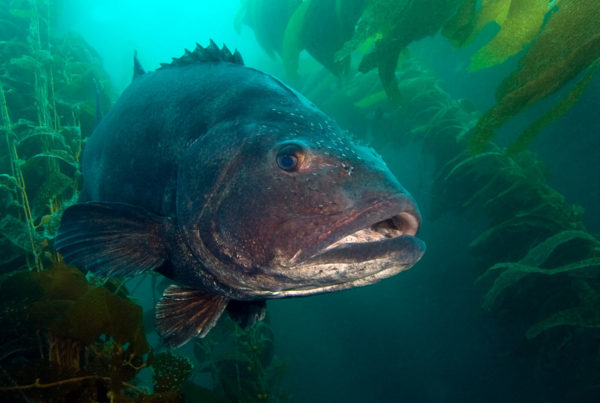In the year 2000, I had the good fortune to make over 25 dives with one of the largest fish found off our Southern California coast, the giant sea bass. This wouldn’t have been much to write about 40 years ago, but today, after years of overfishing by commercial and private fishermen, and being a much sought-after trophy by many spearfishers, the number of these gentle giants has dropped dramatically. However, since a moratorium on landing these fish has been in place, this species has been slowly making a comeback, and the number of divers encountering these gentle giants has increased as well.
There is no mistaking a giant sea bass. I have found them in lush kelp forests from 40 to over 100 feet deep. Their colors may range from a dull charcoal-gray to a shiny aluminum, both with white underbellies. Some have tennis ball-sized spots along their sides, although I have encountered many without spots. But the most tale-telling sign of this particular species of fish is its huge size. A giant sea bass can measure up to seven feet long and weigh in excess of 500 pounds. They certainly make their presence known; hence, their name “giant sea bass.”
An encounter with one of these animals is truly special. However, swimming after one just leads to disappointment. With a couple swift kicks, this gentle giant can disappear in no time flat. In my experiences with giant sea bass, I have found them to be territorial animals, and often just by staying in certain areas, I have found greater success allowing them to swim up to me, rather than my trying to catch up to them. In my most exciting encounters, I have accidentally disrupted a sea bass to the point where they swam off just to have them later return to the same spot to study me as I eagerly photograph them.
When you encounter a giant sea bass, let it make the first move. Let the giant sea bass approach you. If the animal does not approach close enough, stay low and approach it extremely slowly, always staying in its line of sight. Analyze the animal’s body language; if it makes any nervous movements because you are approaching too aggressively, let that be a sign to either slow down or even stop. If you don’t, the only picture you will get will be a memory.
Position yourself slightly below the fish. This does two things: first, it makes the animal look the size that it is; second, it allows for some blue water, sun, kelp, etc., into the background, showing the giant sea bass in its natural surroundings.
I prefer to photograph giant sea bass with a 28mm lens. This is a great lens for photographing sharks and sea lions as well, and it also does a great job of creating a very pleasing look for giant sea bass.
With the basics covered, the hardest part of photographing giant sea bass is the lighting. There is no time more important than now to understand the limitations of your strobe(s). You need to pick an effective aperture for the distance between your subject and yourself. To determine the effective aperture, refer to your strobe’s owner manual for its specifications, i.e., guide number. Also important is understanding the lighting angle your strobe(s) equipment projects. Remember the Golden Rule of underwater photography: “Never light the water between your lens and the subject.” So how do we achieve this? Simple. Use medium- to long-length strobe arms, and correctly point your strobe(s) straight ahead, creating an imaginary parallel line to the line of your lens.
With aperture, shutter speed, and strobe positioning problems solved, successfully photographing giant sea bass involves solving two more unique problems. First, as I stated earlier, giant sea bass come in a broad range of colors, from charcoal-gray to a shiny aluminum color. More important than their color, some bass are far more reflective than others. A photographer needs to realize this before taking photographs. A darker bass has a tendency to absorb a lot of light, making it hard to expose the film properly. Opening the aperture by perhaps half a stop might make the difference in the exposure necessary to properly expose a dark-colored giant sea bass.
A lighter colored animal will reflect much more light, so you will need to either close down your aperture or power down your strobe(s) so as to not overexpose. Secondly, as I stated earlier, a lot of bass are extremely counter-shaded. What this means is that they are dark colored on top and light colored on the bottom, creating another difficult lighting situation.
I have found that keeping my strobe(s) high above the lens, pointed straight ahead, will give me a nicely balanced lighting effect. The light underside of the bass is lit only by the edge of the strobe’s beam, which is all the light that is needed for proper exposure.
After determining the proper aperture setting, select a shutter speed that allows the amount of ambient light needed to create the look you want for the background. Also, the amount of sunlight, time of day, water clarity, and depth at which you are diving all play key roles in determining the amount of ambient light available. Pay close attention to your shutter speed. If the shutter speed is too slow, you may experience subject movement blur and/or camera movement blur, both of which can ruin an otherwise great photo opportunity.
This may seem like a lot of information to absorb just for taking a few pictures underwater. But I can assure you that I have wasted dozens of rolls of film perfecting this solution to this lighting nightmare. Once all the necessary adjustments have been made, beautiful photographs will reflect your hard efforts.










